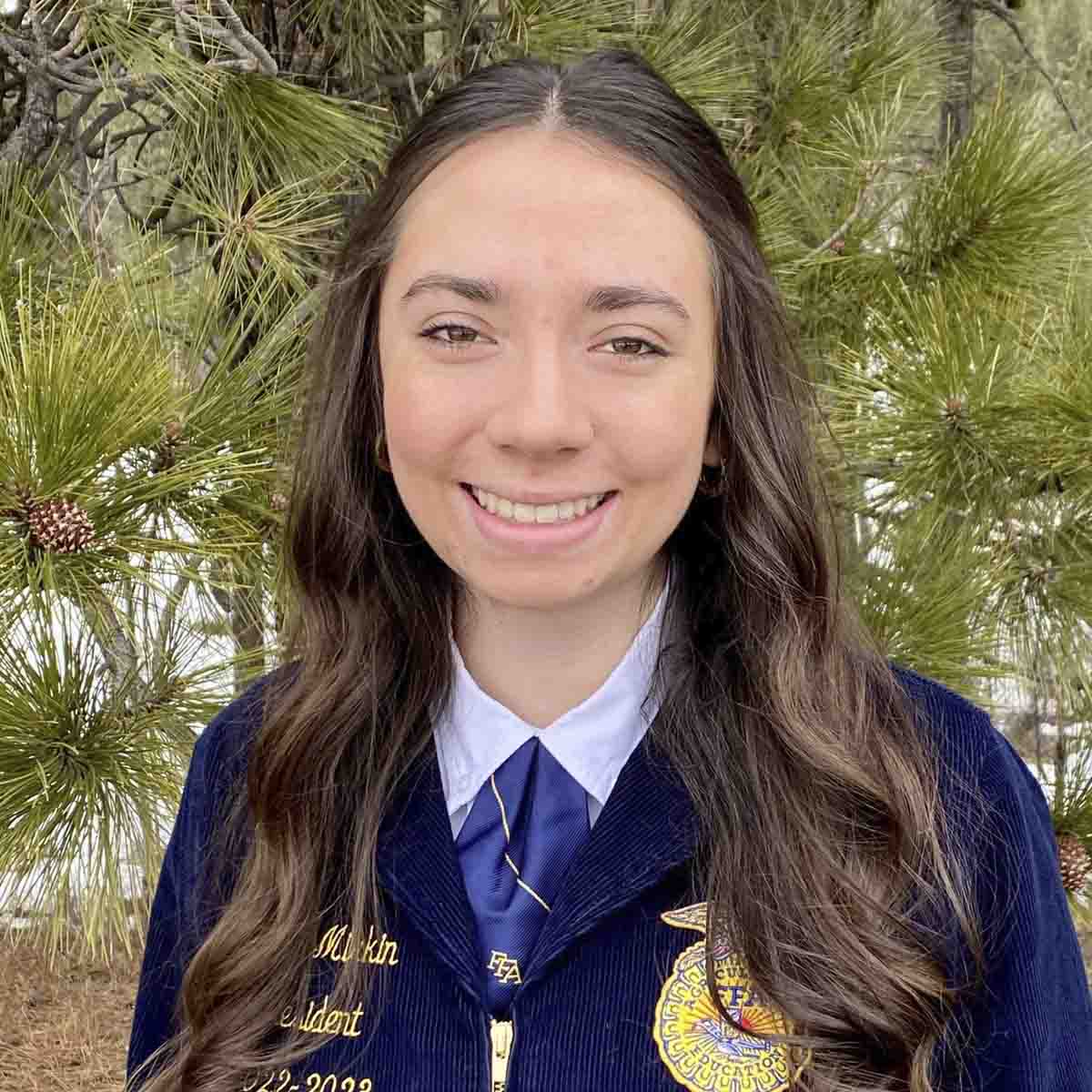Catching Up with CALS — Sept. 20, 2023
By the Numbers
The University of Idaho partners with 6 other entities involved in the Tri-State Potato Breeding Program, including the USDA Agricultural Research Service, Washington State University, Oregon State University and the potato commissions representing each of the 3 states. U of I is responsible for conducting field evaluations of new varieties, constructing best-management practices and working with the partners to identify varieties that would benefit the potato industry and getting them released. The program has released about 40 commercially available potato varieties since it was established in 1983. It receives about $1 million in annual royalties. The No. 1 variety planted is Clearwater Russet. The program starts with 100,000 to 110,000 single hill clones being planted for evaluation. The number of clones is gradually whittled down with each successive generation of planting, and it takes 12 to 15 years for a variety to be released from the time a cross is made.
Our Stories

Pesky Weed Targeted
Madison County rancher Galen Lusk has grown accustomed to finding isolated patches of leafy spurge within his dryland pastures in recent years.
This season, however, a wet spring provided idyllic conditions for the resilient noxious weed to run rampant throughout his rangeland. Lusk was among several farmers, ranchers and weed control experts who attended a recent University of Idaho Extension forum hosted in a Rexburg park to highlight the mounting regional threat posed by leafy spurge.
“I keep cattle out there in the spring and calving time and again in the fall, but where it used to be all grass, now it’s covered with yellow in the blossom time,” Lusk said, referencing the pretty yellow flowers the plant produces, often alerting landowners of a weed infestation. “We’re at the point where we’ve got to do something.”
The event’s organizer, UI Extension Educator Jared Gibbons, emphasized eliminating leafy spurge usually requires a multi-pronged strategy and several years to accomplish.
Throughout June, when leafy spurge was in bloom, Gibbons, a cropping systems agronomist who started with UI Extension in Madison County last fall, fielded several calls from landowners seeking advice on control methods.
The creeping perennial weed, native to Eurasia, creates monocultures and can reduce the carrying capacity of rangeland by 50% to 75%. Seed can be discharged up to 15 feet away, and the root system can spread up to 15 feet wide and 30 feet deep. The plant’s sap contains toxins that cause irritation and digestive problems in both humans and livestock. Wet weather this spring enabled the weed to spread rapidly in much of eastern Idaho.
“We just realized it was a lot bigger and a lot more well established this year than the past and it had really taken off in some areas,” Gibbons said.
Gibbons advises landowners to fight back against the weed using a combination of herbicides, biological control agents such as insects that feed on leafy spurge, tillage and even goat grazing. Other livestock, such as cattle, consume leafy spurge only as a last resort as it makes them sick.
Gibbons has been adding GPS pins to a mobile app, EDDMapS, identifying locations where he encounters previously undetected leafy spurge. The app requires users to submit a photo for a weed sighting to be verified. Gibbons also plans to collaborate more closely with county weed officials and other stakeholders in coordinating attacks against leafy spurge.
During a discussion about how to identify leafy spurge, UI Extension Educator Joseph Sagers joked, “It looks like most of Madison County is what it looks like.”
Some counties have taken to deploying biological control agents to fight leafy spurge using drones.
“I think there’s a lot of potential in these biologicals,” said Sagers, who is based in Jefferson County. “I just wish they’d get them propagated so they’d be more available to more people.”
Landowners using herbicides to battle leafy spurge should make two to three applications spanning from June through August, preferably using herbicides with different modes of action. County weed superintendents can apply to receive herbicides funded by the state to share with landowners, who typically split the cost of applying chemicals with their county.
Leafy spurge has been spreading along canals and waterways in recent years. It’s extremely challenging to control where it grows near water, as certain herbicides are restricted from use in wet areas. Furthermore, the best insects for biological control of the weed can’t survive in riparian habitat.
Ririe farmer and rancher Gordon Gallup has noticed leafy spurge proliferating along canals and streams through his property.
“It’s been a prevalent weed for probably 15 or 20 years, but it seems like its territory is expanding,” Gallup said. “It’s tough to kill. You need to be proactive or you’re going to have a mess.”

Managing Medusahead with Cattle
A multi-year study involving University of Idaho researchers has found allowing late-fall and winter grazing on rangeland heavily infested with invasive Medusahead grass could provide extra forage for cattlemen while reducing wildfire fuel.
“Managing Medusahead Using Dormant Season Grazing in the Northern Great Basin,” recently published in the 2023 edition of Rangeland Ecology and Management, also concluded grazing in the fall and winter did not negatively affect native perennial grasses.
University of Idaho Extension Educator Scott Jensen, based in Owyhee County, and Eva Strand, an associate professor of rangeland ecology and management with U of I’s College of Natural Resources, were among the authors.
Other authors included William Price and Sergio Arispe, with Oregon State University (OSU) Extension; April Hulet, with Brigham Young University; Chad Boyd and Kirk Davies, with the U.S. Department of Agriculture Agricultural Research Service Eastern Oregon Agricultural Research Center; Dustin Johnson and Yanming Di, with OSU; and Barry Perryman, with University of Nevada-Reno.
Medusahead, an annual grass native to the western Mediterranean region of Eurasia, has invaded nearly 5 million acres of rangeland throughout the West, posing a host of problems for rangeland health including loss of species diversity, diminished forage quality and increased fine fuels for wildfires. It thrives in lower elevations, in areas in which soil is disturbed, and it germinates in the fall and dries much earlier during the following spring than other vegetation. It is fine stemmed, causing it to fall over and form mats that can choke out native perennials, and cattle tend to avoid eating it due to its long awns and high silica content.
“The heavily infested Medusahead areas are just a tinderbox waiting for some kind of ignition source,” Jensen said.
In June, the research team finished collecting its sixth year of data from the study, based in the 138,800-acre Three Fingers allotment, located within the federal Bureau of Land Management’s Vale, Oregon, district.
“It’s an area that sees a lot of lightning. Five or six ranchers who have had enough of frequent fires in that allotment approached my colleague in Malheur County, Oregon, Sergio Arispe, and said, ‘We’ve got a recurrent fire problem. Can you help us figure something out?’” Jensen said.
Following a year of gathering baseline data, the partners secured a $300,000 grant in 2018 covering five years of treatments from USDA’s National Institute of Food and Agriculture.
The allotment is divided into four pastures. There are two replications of the treatment plots in each of three of the four pastures. One treatment involved a traditional grazing season from May 1 through Nov. 1. The second treatment involved grazing during the season in which grasses are dormant, from Nov. 1 through March 1. The third treatment allowed grazing during both the regular season and dormant season combined. A control treatment in each set of plots is not grazed at any time or season. Grazing reduced Medusahead litter and provided forage for cattle without harming native perennials, though annual grass and native perennial grass cover did not differ significantly among treatments.
“Our control area has more pounds per acre of litter and biomass than areas that get grazed,” Jensen said.
Precipitation affected outcomes. In years with wet falls, Medusahead sprouted within the fallen weed litter, enabling cattle to feed on the emerging seedlings in the thatch. The moisture also softened the litter layer, making it easier for cattle to consume it. The researchers used protein supplements to lure cattle into weedy areas to feed, which also better balanced the nutritional value of the forage.
“When there has been no fall precipitation then we don’t get the fall germination, and we also have an issue with livestock water,” Jensen said.
Late fall and winter grazing also spared ranchers some expense of buying hay for winter feed.
William Price led the project in its first couple of years as a University of Idaho master’s student, prior to joining OSU Extension. Price and his wife have continued to assist each June with data collection. The grant also funded temporary help to aid gathering data. The researchers take detailed imagery from transects within three locations of the allotment. They also clip and weigh biomass within the transects.
Two other papers were previously published based on the project. “Strategic Partnerships to Leverage Small Wins for Fine Fuels Management,” was also published in Rangeland Ecology and Management, focusing on the collaborative nature of the research team. For the other paper, “Estimates of Fine Fuel Litter Biomass in the Northern Great Basin Reveal Increases During Short Fire-free Intervals with Invasive Annual Grasses,” the team collaborated with Spanish researcher Jose Manuel Fernandez-Guisuraga, who used their data and imagery to guide development of a tool using satellite imagery to predict forage amounts and types on range.
Jensen and his colleagues obtained a 10-year research exemption from the regular grazing plan for the Three Fingers allotment. They plan to continue the research project throughout the remaining four years of the exemption.
"I'm always hopeful that because of some of the things we learn from this that we could provide land managers an avenue to allow more flexibility in management,” Jensen said.

Malnutrition Awareness Week
Idaho will observe Sept. 18-22 as Malnutrition Awareness Week, based on a University of Idaho nutrition researcher’s request to the state.
Yimin Chen, an assistant professor specializing in human milk research within the Margaret Ritchie School of Family and Consumer Sciences, applied for the special designation on behalf of the American Society for Parenteral and Enteral Nutrition (ASPEN), which is devoted to advancing the science and practice of clinical nutrition and metabolism.
Malnutrition Awareness Week, which ASPEN established in 2012, is a multi-organizational effort to educate healthcare professionals about early detection and treatment of malnutrition, increase awareness about the importance of nutrition in patient recovery and educate consumers about the need to discuss their level of nutrition with healthcare professionals.
The designation is renewed annually, enabling the organization to keep the issue of malnutrition at the forefront of discussions among state lawmakers each year, potentially affecting how they vote on bills related to nutrition. Designations for 2023 were approved in 11 states, including Idaho, plus Washington, D.C., and Puerto Rico. Idaho also approved a Malnutrition Awareness Week in 2022.
Chen is a longtime ASPEN volunteer who has served on several of the organization’s committees and started its neonatal section. ASPEN wrote the proclamation Gov. Brad Little’s office recently adopted, which notes more than 2 million hospital stays annually result from malnutrition and that malnourished patients have triple the mortality rate compared with other hospitalized patients. The proclamation also emphasizes that screening, assessment, diagnoses and intervention are key to addressing the problem.
The Idaho Commission on Aging made a separate request for the state to adopt Malnutrition Awareness Week covering the same dates.
“I’m definitely very proud of this and I probably wouldn’t have been able to do it myself without this streamlined process ASPEN has developed,” Chen said. “It’s really cool to see that more and more states are agreeing to essentially put out this type of proclamation so hopefully nationwide we can have this awareness and get the message out.”
Chen and her colleagues with ASPEN will capitalize on the week as an opportunity to share messaging about malnutrition and dispel widely held myths on the subject. For example, it’s widely held that emaciation is the best indicator of malnutrition, though malnourished people can often have a normal bodyweight and aren’t getting key nutrients.
Furthermore, patients may have a chronic disease, such as cancer or a gastrointestinal disease, preventing their body from taking in adequate nutrition, and their malnourishment is often left undiagnosed.
“Hopefully what this awareness will do is improve reimbursement for dietitian services,” Chen said. “If the physicians can consult dietitians on these cases earlier on and get reimbursed for it so insurance, Medicaid or Medicare will pay for these services then these patients can be intervened much earlier on before they become malnourished and end up in a hospital and have all of these morbidities associated with it.”
Chen started her career as a clinician, working eight years in a surgical intensive care unit and seven years in a neonatal intensive care unit. Through that experience, she found there was too little research to back up clinical practice guidelines, which furthered her interest in conducting her own research.
While working at Rush University Medical Center in Chicago, Chen and members of the specialized nutrition support team she led conducted a cost savings analysis involving dietitians writing parental nutritional orders rather than resident physicians, as usual. Her team proved the hospital achieved considerable savings when dietitians wrote the orders and improved laboratory outcomes due to reductions in errors and miscalculations. As a result, the hospital updated its policies to grant order writing privileges to dietitians.
Chen conducted additional research comparing screening tools used to identify malnutrition among intensive care unit patients.
With U of I, Chen started research in 2019 to better understand how a mother’s stress level affects milk composition, as well as the potential health consequences for breastfeeding infants. She and her team are preparing a manuscript of their findings regarding the immune profile of milk from stressed versus non-stressed mothers. The researchers are further evaluating the potential for meditation over several weeks to reduce a mother’s stress and reduce inflammatory molecules in milk. Chen and her team are also investigating how digestion-released peptides from human milk may modify intestinal inflammation, relevant to preterm infants at high risk for developing necrotizing enterocolitis, a severe inflammatory bowel disease.
Chen is also in the second year of ASPEN-funded research comparing piglets fed on a mother’s milk versus infant formula, assessing potential differences in inflammatory responses from the gut and systemic circulation to the brain. This research will be the first to begin understanding the potential mechanisms behind differences seen in cognitive functions in children fed mother’s milk versus infant formula.
“I love to think about nutrition as a whole-body system, not as a single discipline because your whole body connects together,” Chen said.
Faces and Places
Dean Michael Parrella recently attended a meeting of the University of Idaho Student Idaho Cattle Association to talk with students about CALS initiatives related to the livestock industry.
Senior Instructor Lori Wahl received a grant from Cotton Incorporated for the project, “Integration of Virtual and Physical Cotton Fabrics into an Apparel Technical Design Course."
Apparel, textiles and design student Asiah Brazil-Geyshick's undergraduate research project on creating textiles from kombucha was recently featured by the Modern Farmer.
The Chobani Scholars program has awarded a total of $100,000 in scholarships to five Magic Valley area students who are newly enrolled at University of Idaho and are poised to make meaningful contributions to agriculture. Recipients include Megan Taber, of Shoshone, who is majoring in animal and veterinary science: production and mechanical engineering; Melody McHan, of Gooding, who is majoring in animal and veterinary science: business; Kamille Mirkin, of Jerome, who is majoring in agricultural economics: agribusiness; Josiah Knapp, of Hagerman, who is majoring in agricultural science, communication and leadership; and Madeline "Zara" Burgoyne, of Rupert, who is double majoring in water science and management and forestry. Learn more.



Events
- Sept. 19-Nov. 14 — Get the Dish Virtual Cooking Series, Online
- Sept. 21 — Freeze Drying Done Right Virtual Food Safety Workshop, Online
- Sept. 22-24 — CALS Days 2023, Moscow
- Oct. 5-6 — Rangeland Fall Forum 2023, Nampa and Boise
- Oct. 18-April 17 — Heritage Orchard Conference, Online
- View the schedules and links to county fairs in your area

















